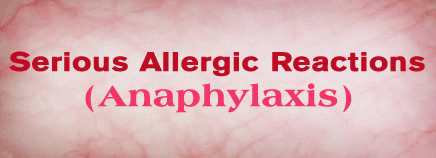
Kids with severe allergies can be at risk for a sudden, potentially life-threatening allergic reaction called anaphylaxis. This reaction can be frightening — a child may feel like his or her throat is closing or might faint, for example.
But the good news is that when treated properly, anaphylaxis can be managed.
Anaphylaxis isn’t common, but some kids with allergies are more at risk for it. So if your child has allergies, it’s important to know about it and be prepared.
Signs of Anaphylaxis
 As with other allergies, anaphylaxis can trigger symptoms in any of these four body systems:
As with other allergies, anaphylaxis can trigger symptoms in any of these four body systems:
- skin
- digestive system
- respiratory system
- cardiovascular system
An allergic reaction might be a medical emergency if it happens in two or more of these systems — for example, hives on the skin together with stomach pain.
The most common signs that someone might have anaphylaxis after exposure to an allergen are:
- difficulty breathing
- tightness in the throat or feeling like the throat or airways are closing
- hoarseness or trouble speaking
- wheezing
- nasal stuffiness or coughing
- nausea, abdominal pain, or vomiting
- fast heartbeat or pulse
- skin itching, tingling, redness, or swelling
Fast Treatment Needed
Anaphylaxis requires immediate treatment. It can get worse very quickly. This is why doctors usually want people with life-threatening allergies to carry a medication called epinephrine. Epinephrine enters the bloodstream and works quickly against serious allergy symptoms; for example, it decreases swelling and raises blood pressure.
Epinephrine is given as an injection. This isn’t as scary as it sounds, though — there’s no big needle and plunger involved. Instead, doctors will prescribe an auto injector about the size of a large pen that’s easy for parents — and older kids — to carry and use. If your child is prescribed epinephrine, your doctor will show you how to use it.
Your doctor also might instruct you to give your child over-the-counter (OTC) antihistamines, too — but they won’t work alone. OTC antihistamines are never a replacement for epinephrine in life-threatening reactions.
If Your Child Has a Serious Reaction
If your child shows signs of a serious allergic reaction:
Step 1: Give the epinephrine auto-injector right away. Seconds count during an episode of anaphylaxis. If you are alone with your child, give this medication first, then call 911. If you are not alone with your child, have someone else call 911 while you give the medicine.
Step 2: At the emergency room, additional treatment can be given, if needed. Also, your child needs to be under medical supervision for at least 4 hours because even if the worst seems to have passed, a second wave of serious symptoms (called a biphasic reaction) often happens.
Serious allergies can be alarming. But they’re a lot easier to recognize and treat now than in the past, thanks to greater awareness and the availability of epinephrine. Also, make sure that any caregivers, teachers, or coaches know about the allergy and what to do in an emergency.

